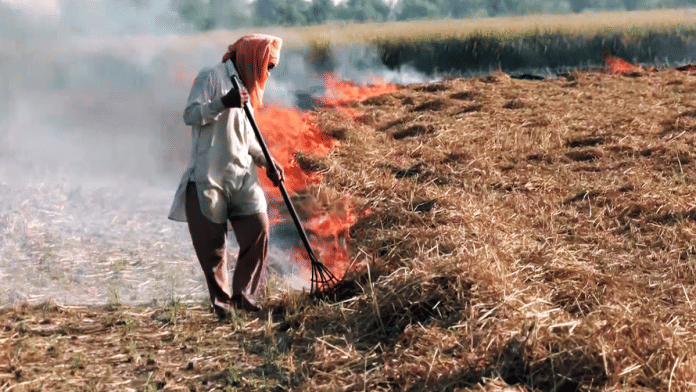New Delhi: Uttar Pradesh and Madhya Pradesh are the new stubble-burning hotspots in north India this year. Government data shows that within the first fortnight of October, the states recorded the highest number of fires, leaving the usual suspects—Punjab and Haryana—behind by a huge margin.
Satellite data from the Consortium for Research on Agroecosystem Monitoring and Modelling from Space (CREAMS) managed by the Indian Agricultural Research Institute (IARI) shows that between 1 and 14 October, 158 fires were reported in UP, and 70 in MP. Punjab and Haryana, which have been under scrutiny for years for burning stubble, recorded only 39 and 9 fires respectively, while 26 fires were reported in Rajasthan.
Large-scale paddy stubble burning in north India—primarily concentrated in Punjab and Haryana till recent years—has become one of the factors contributing to the alarming rise in pollution levels in the national capital territory every year.
Plumes of thick, black smoke choke Delhi, adding to its already high pollution levels. The onset of winter, with lowered temperatures and slow winds, concentrates pollutants closer to the surface and sets the stage for the coming months.
Environmental experts, however, say that this season, stubble fires in Punjab and Haryana have been lower compared to previous years.
Heavy rains and floods damaged a large majority of the paddy crops in Punjab this year.
Ravindra Khaiwal, professor of environmental health at Chandigarh’s Post Graduate Institute of Medical Education and Research (PGIMER), said, “There are a lot of hotspot (stubble burning) districts where large parts of the crops have been damaged by this season’s floods. That surely will have an impact on the number of stubble fires. But we will have to wait and watch.”
Punjab and Haryana governments have previously stressed that pollution monitoring agencies have been making consistent efforts to encourage farmers to mechanically remove paddy stubble rather than setting their fields on fire. This, according to them, has reduced the number of farm fires.
LS Kurinji, programme lead at the Council on Energy, Environment and Water (CEEW), a Delhi-based thinktank, said, “Both the Centre and the state governments have been giving incentives and conducting campaigns to get farmers to use crop residue management machines like Happy Seeders. We have observed that there has been a change in the mindset of farmers because of these efforts.”
Rise in fires in UP and MP
The CREAMS laboratory satellite data shows that the rise in stubble fires in UP and MP is not a sudden trend.
In 2024, UP recorded 3,308 stubble burning incidents, compared to 2,649 in 2023. The situation in MP was worse. Madhya Pradesh had 16,360 fires in 2024, a significant rise from 2023’s 12,500 fires. Satellite data shows that last year, six out of 10 districts that reported the most farm fires were from MP.
Officials from the Union Ministry of Environment, Forests, and Climate Change said a possible cause for these two states joining the ranks is due to an increase in the share of paddy farming in the region.
Agriculture ministry data shows that in 2023-24, UP emerged as the state with the highest acreage under paddy, with 74.25 lakh acres under its cultivation, followed by West Bengal (55.59 lakh ha), Telangana (48.09 lakh ha), and MP (39.93 lakh ha).
“UP and MP are also getting caught in the paddy-wheat crop cycle now. The more the acreage of paddy, the greater the risk that the farmers will resort to stubble burning,” the official told ThePrint.
(Edited by Insha Jalil Waziri)
Also Read: Delhi air pollution warning system could only predict 5 of 14 ‘severe’ days last winter—CEEW study






